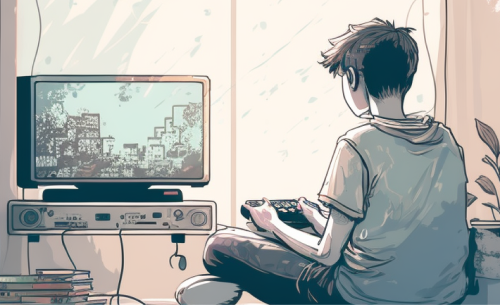Any child that has access to an internet-connected device unsupervised can be vulnerable to online child sexual abuse. The internet has enabled perpetrators to operate at scale and pace and made it easier for them to make contact with children and teenagers while avoiding physical contact.
Know the four categories of risks
It is important to be aware of the fact that risks are generally grouped into four categories (the 4Cs):
Content
The child is exposed to illegal or harmful content (age-inappropriate content, hateful content, extreme violence, pornography, age-inappropriate content, etc.).
Conduct
The child is an actor (perpetrator or victim) in an exchange that is harmful. This may also include their own behaviour making them vulnerable (bullying, sexting, non-consensual sharing of content, trolling, threats, intimidation, etc.).
Contact
The child is targeted or experiences a potentially harmful interaction (harassment, grooming, stalking, location sharing, child sexual exploitation, unwanted sexual advances, etc.).
Contract
The child is party to or exploited by a potentially harmful contractual pressure or relationship (targeted advertising, hidden costs, loss of control of personal data and identity theft, scams, unknown acceptance of digital products or services).
Understand the emerging risks for children and youth
Cyberbullying
Cyberbullying is abusive, targeted, deliberate and repeated behaviour intended to harm another person through technology. Sometimes sexual images and videos are created and distributed as a form of bullying, or email accounts and social media profiles are stolen to humiliate and hurt someone. Threats, harassment, humiliation can happen via text messages, emails, chat rooms, online forums, on social media websites.
Online gaming
Online gaming is a common pastime which provides an opportunity for connection, particularly with people who share a common interest. Unfortunately, many people experience online harassment while playing games that can also cross into real life with augmented reality.
Gamers often have a choice about what personal or contact information to share through an online profile or chat conversations with other players. When moving into virtual or augmented reality, privacy and safety concerns increase: for instance, augmented reality games may allow geolocation of a player in order to let other gamers interact with them at a shared location.
Players have reported experiencing harassment, stalking, death threats, rape threats, doxxing. These experiences are very traumatising. In some cases, and if enough identifying information is available, the abuse could move from the online to the offline dimension, in real life.
Online grooming
Online grooming means that an unknown person (often an adult) impersonates someone else, for example a teenager, to try to gain the confidence of children or young people, inducing them to share certain information and then abuse his/her position of power in one way or another. The enticement of children or teenagers entails a process of preparing them for future sexual contact through a gradual building of trust which may take time, but can also happen very abruptly.
Communication happens through technology, like texting or chatting through an app/game/website, to make it easier to commit a specific sexual offence against them. It can be the first step towards sex trafficking. The stages of grooming involve:
Identifying the victim
Perpetrators may pry on age, appearances, vulnerable traits known or shared online (low self-esteem, absence of parents, a recent move, looking for a place to live in, etc.).
Gaining trust and access
Perpetrators may be very smooth and kind, or offer help.
Becoming important and giving something the victim need
Often through manipulation (flattering, gifts).
Creating secrecy to isolate the victim
Induce the victim to not share information with anyone else or tell the child that (s)he will get into trouble if (s)he tells an adult what has been going on.
Sexualizing the relationship
Ask questions of sexual nature or share sexual comments or content.
Controlling the relationship Anything happened will become a leverage to exert pressure and power over the victim.
Promises of financial returns
A common way to establish contact is promises of financial returns, a career in modelling, dancing or music, and a way out of what were seen as situations in which the victims were trapped and had few opportunities.
This may be done through a combination of peer recruitment (someone the victim knows and who may be himself/herself a victim that is being coerced to do so) and an alleged ‘talent agent’, primarily through Facebook Messenger, Instagram, before escalating into direct contact with the victims over WhatsApp/Telegram and video calls. In this instance, the offender takes advantage of the implied trust inherent in online friends and networks.
Lover Boy
Offenders make friends with potential victims over social media like Instagram, Facebook, or dating apps. They gain the victim’s trust before moving the conversation towards more romantic and sexual topics.
Offenders use tricks like flattering the victim, promising gifts or a better life, and assuring them that they are the only one who cares for them. Sometimes, they use a victim’s past bad experiences to convince them that they can make them happy again.
Offenders can tell if a victim is vulnerable by looking at their social media posts and comments. They can build a relationship with a victim by pretending to be the only one who understands them or is going through the same thing. For instance, if the victim posts something like “How do I look?” or “Nobody gets me,” the offender can use it as a way to relate to the victim’s feelings and build a relationship.
Sextortion
Online sexual coercion and extortion of children, also called ’sextortion’ is, simply, put, extortion using sex. It occurs when someone online threatens to send a sexual image or video of you to other people if you don’t pay the person (financial aim) or provide sexual services or more sexual content (sexual aim). The use of live-streaming services has increased the vulnerability particularly of youth to this type of exploitation because they can be recorded without their knowledge and then blackmailed. So how does ‘sextortion’ occur?
Youth (boys in particular) are often deceived into believing they are communicating with a young female. The contact occurs over a short period of time, in most cases over several hours but in some cases may take as little as 20 minutes.
It involves an exchange of sexual content, with the other side often sharing first. Oftentimes, the youth is tricked into sending a sexual photo or video but the youth may also be tricked into exposing themselves or engaging in a sexual act over a livestream and being recorded without their knowledge.
The request for money from the extorter is almost immediate. The extorter threatens to leak the content online and/or share with the youth’s family or the friends’ network if they don’t comply. It is common for the offender to share screen captures of the youth’s contacts or other identifying information (school, home address) to terrify the youth so they agree to send money.
If the youth complies, the extorter will demand more money be paid.
Frequent communication tactics in sextortion
Offenders may approach young people on social media, using information they have gathered about their friends, interests, school, and family to appear trustworthy. They may also pretend to be younger or of the opposite sex to gain the child’s trust.
Once contact has been made, offenders may quickly ask for nude images or move communication to a different platform, such as a private video chat or messaging app, to avoid detection. Reciprocation is another tactic that may be used, where the offender says “I’ll show you if you show me.”
Offenders may also pretend to work for a modeling agency or use multiple fake identities to establish a bond with the child. In some cases, offenders may offer money or drugs to the child in exchange for explicit material.
The most severe form of manipulation involves threatening to create sexual videos or images of the child using digital editing tools and then sharing them, often by stealing them from the victim’s online profile.
What can you do as a parent, carer or educator?
It’s very important to have age-appropriate conversations with children and teens about the risks associated with using technology, as children’s understanding of digital privacy and security may differ based on their age. For instance, younger children (5-7 years old) may have a certain sense of privacy, but find it difficult to understand the consequences of their actions.
Teens will often comply with online threats in an effort to manage the situation in the short term and on their own since it is often very difficult for them to seek adult assistance if they’re embarrassed and/or scared. The desire to meet the individual in person could place the teen in a dangerous situation.
While a zero-risk online environment does not exist at the moment, educators and parents can make sure that their children become safe and responsible users on social networking websites, by teaching them about internet safety, being aware of their online habits and directing them to appropriate websites.

Learn about social media and Internet
Stay informed of the latest Internet websites and social media that children make use of. Seek information about parental controls and access limitations that some social media platforms enable. For example, you can easily find guides for WhatsApp, Instagram, Facebook, Messenger, or TikTok.
Get involved. Spend time online with your child, whether at home, at school, at a computer centre in your community.
Place your child’s computer into a family room or a frequented room, this may limit the visiting of potentially dangerous chat rooms and social networking websites, as most teens prefer to view these sites in private. You may also want to limit your child’s use of the computer to certain times, such as when you are home or in the room.
Familiarise yourself with some acronyms commonly used on social networks by teens and which may be used by predators:
- S2R – Send To Receive (pictures)
- FWB – Friends with benefits (friends who occasionally have casual sex)
- FYEO or 4YEO – For your eyes only (may indicate explicit photos)
- PIR – Parent In Room
- PAW – Parents Are Watching
- POS – Parent Over Shoulder
- CD9/Code 9 – Parent/Adult around
- GNOC – Get Naked On Cam
- TDTM – Talk Dirty To Me
- NIFOC – Naked In Front Of Computer
- (L)MIRL – (Let us) meet in real life
- MOS – Mom Over Shoulder
- P911 – Parent emergency / Parent alert
- PRON – Porn
- SWAK – Sealed with a kiss
- GYPO – Get your pants off
- IWSN – I want sex now
- KPC – Keeping parents clueless
- LMIRL – Let’s meet in real life
- OC – Open crib (= no parents will be home)
- ASL(R P) – Age Sex Location (Race/Picture)
Create a safe space and engage your children
Talk to your children about the dangers of the Internet. Bottom line is: stay alert when using digital media. People aren’t always who they seem to be, even in real life, and sometimes they change and do mean things. Discuss with your children about being critical thinkers when online, in terms of recognizing false information, advertisements. Critical thinking about what we upload as well as download is the best protection.
Reassure them that if they are harassed or experience uncomfortable situations online, whether it be by someone they know or do not know, they must contact you immediately. Talk about the possible legal consequences: taking or sending nudes or sexually suggestive photos of yourself or anyone else may have legal consequences (for instance, for possession or distribution of child pornographic content).
Discuss also the possible non-legal consequences: intimate photos of yourself may go to a friend who can then become an ex-friend and send it to everyone you know. People may decide to share them out of peer pressure, anger (after a breakup), or to blackmail you.
Have an open two-way dialogue with your children about sexting in a relaxed setting. Ask them what they know about it (they may not have heard the term, so “naked photo-sharing” works too). Express how you feel in a conversational, non-confrontational way. Teach your children about settings and tools available on different platforms to use the internet more safely. Encourage them to use them. Talk about the red flags and practice tips together.
When considering parental controls, take the time to discuss with your children about the options and have them participate in the decisions that affect them. Allow them to share their views in a safe and comfortable manner before a decision is made, and show that you take them seriously. Inform them once a decision has been taken. Talk to other parents about their digital parenting practices: you can get a lot of support and guidance from the people around you, and people around you could likewise benefit from support and guidance from you.
Be a positive role model
If your child sees you making hurtful comments on a social networking site or not practising safety tips, they will be less inclined to listen to your guidance about how they should use the internet. Model good behaviour so that they know what such behaviour looks like.
How you can start a conversation with your child?
What is the difference between people we only know online and people we know offline as well?
How do we know that we can trust someone?
How do we know that we have reason to trust information on the internet?
Not all messages from someone new online are worrying, but how do you know which ones might be?
Do you know where the report and block buttons are on different apps?
What would you do if you saw someone sharing something fake or inaccurate?
Who can help you if you see something or talk to someone that you’re not sure about?
What things make you happy when you use technology?
What things worry you/ make you unhappy/angry/sad about life online?
How do you stay safe online? What tips do you have for me, where did you learn them? Can you show me some of them so I can learn too?
What is ok and not ok to share?
What have you heard about (sharing photos, grooming,…) online? What would you do if this happened?
Can we talk about ….? Remember, I’m always here to help no matter how big the problem might feel.
I can see that something is worrying you, can I help?
Adults should be particularly vigilant when children use online gaming platforms and increase their personal safety and privacy online by following some tips:
Choose a username that doesn’t include any real name or other identifying information when creating profiles or accounts. Talk to children about how they can protect their privacy by never giving out identifying or contact information.
Consider using different email addresses, profile pictures, and strong passwords for gaming, and for each game that the children play. This can help avoid doxxing, or prevent other users from being able to connect the gaming profile to real life.
Do a test: search for your children online, or use privacy checking services to find out what information is available about them online.
Educate your children to be careful and not open attachments and links, which might install spyware or other malware on their devices.
Remind your children to trust their instincts. If they start to feel uncomfortable and if it is no longer fun, it’s always ok to cut a gaming session and to cease contact.







